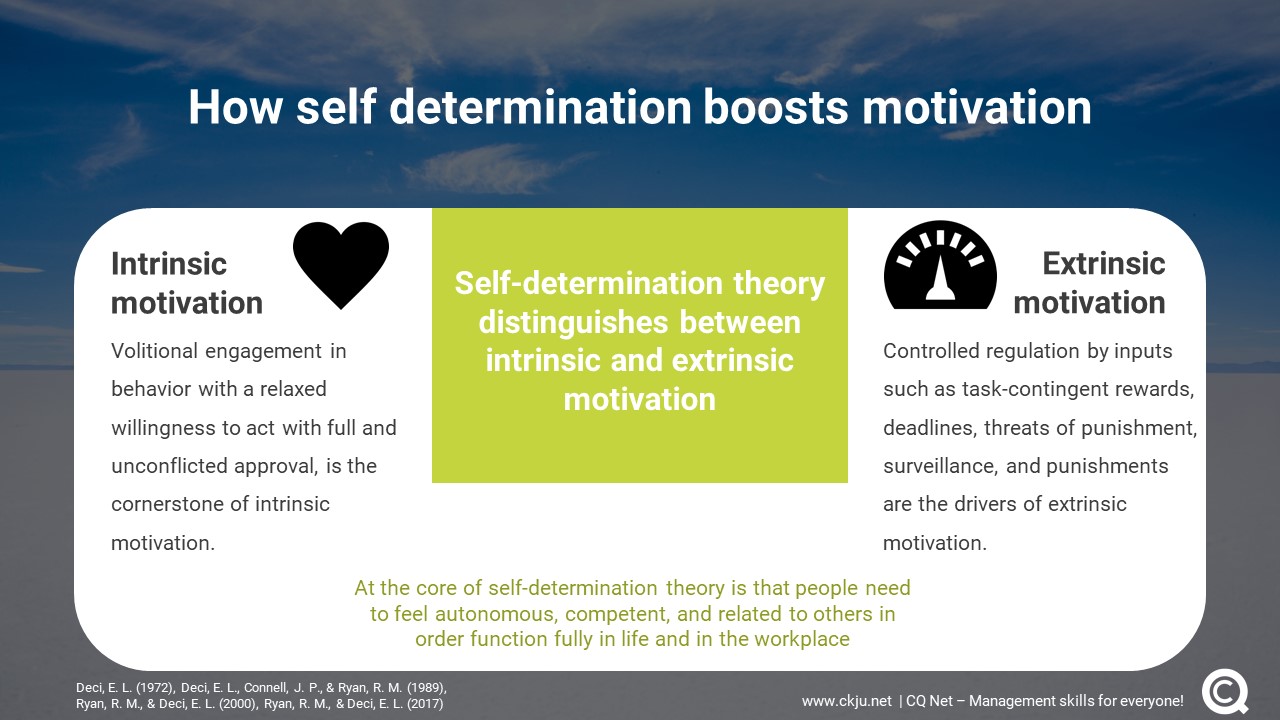- All Management Learning Resources
- Self determination and goals setting

Executive summary
In this CQ Dossier we have a look at the key concept of self-determination and goal-setting theory. We draw on the main theories of self-determination (SDT), mastery motivation and goal-setting theory to provide you guidelines on how best to motivate your peers, coworkers and team members. Furthermore, we describe how you can create a climate based on self-determination theory to empower people around you. We also show how you can use difficult and specific goals to motivate others to go beyond expectations.
Contents
- Executive summary
- Self-determination theory distinguishes between intrinsic and extrinsic motivation
- Goal setting theory states that people are most motivated when they aim for difficult and specific goals
- Intrinsic motivation is relaxed willingness to act with full and unconflicted approval
- Informational input increases self determiniation while controlling input decreases self-determination
- Communication style impacts whether people experience an input as information or controlling
- Autonomously motivated people performen better in the workplace and beyond
- Controlled motivation negatively impacts health
- Goals have the potential to increase motivation
- Goals can have negative side effects under certain conditions
- Key take-aways
- References and further readings
Self-determination theory distinguishes between intrinsic and extrinsic motivation
Self-determination theory (SDT) posits that people are motivated when they engage in action with the intention to achieve an outcome (Ryan & Deci, 2000). It is measured on a learning self-regulation continuum ranging from fully autonomous regulation, which is associated with intrinsic motivation, to wholly controlled regulation, which is associated with extrinsic motivation (Black & Deci, 2000). Motivation to achieve corresponds with the importance of the outcome (Rosenberg, 1965) and, depending on the source of motivation (Deci, 1972), may demonstrate implications for an individual’s sense of self-worth.
Goal setting theory states that people are most motivated when they aim for difficult and specific goals
The source of motivation, meaning the degree to which motivation is intrinsic or extrinsic, can be ascertained by measuring learning self-regulation. Mastery orientation is also derived from self-determination theory and is built on the premise that individuals are driven to develop and demonstrate high ability.
Goal setting-theory is also based on the same assumption that people strive to demonstrate high ability and are most motivated when they aim for difficult and specific goals (Locke & Latham, 1990). This CQ Dossier describes the best ways to cultivate a climate based on self-determination and goal-setting theory.
Intrinsic motivation is relaxed willingness to act with full and unconflicted approval
The central concept in self-determination theory is intention. Volitional engagement in behavior with a relaxed willingness to act with full and unconflicted approval, is the cornerstone of intrinsic motivation (Ryan & Deci, 2000). It has been posited that the source of motivation is instrumental in achievement and that determining motivation’s source can inform excellence in work performance (Ryan & Deci, 2000). Individuals who have a higher degree of intrinsic motivation describe an internal origin of inspiration and self-determination.
Research on goal orientation also suggests that individuals who are motivated to master new information for the sake of learning seem to be more likely to actively process the material and perform better on tasks (Dweck, 1988). Within the workplace, mastery goal orientation is associated with an active cognitive engagement in the task (Stevens & Gist, 1997).
Management skills newsletter
Join our monthly newsletter to receive management tips, tricks and insights directly into your inbox!
Informational input increases self determiniation while controlling input decreases self-determination
The early research on self-determination theory found that when someone is so focused on a task that they are caught up in the moment this results in intrinsic motivation or a flow experience (Ryan & Deci, 2017). However, this early research also found that when you start paying people to perform the task or introduce extrinsic motivation, this distracts from the flow experience and individuals tend to become less motivated (Ryan & Deci, 2017).
When individuals are engaged in a task, any input that they receive that is related to their performance can be classified as either informational or controlling:
- When individuals experience input as informational such as supportive autonomy or promoting competence they experience self-determination (Deci & Ryan, 1989).
- However, when they experience input as controlling such as pressuring someone to think, feel or behave in a particular way this tends to diminish self-determination.
Communication style impacts whether people experience an input as information or controlling
In the area of work performance, when employees are given choice or autonomy and positive feedback to perform their work, these types of input are seen as informational and boost employee self-determination (Deci, Connell, & Ryan, 1989). Controlling inputs are pressures such as task-contingent rewards, deadlines, threats of punishment, surveillance, and punishments. These types of management practices can diminish self-determination (Deci et al., 1989). There are other factors that are important too in determining whether an employee experiences an input as information or controlling. One important factor is the interpersonal context.
When a manager provides an employee with positive feedback the effect on employee motivation can differ depending on whether the employee perceives the input as informational or controlling. In fact, it seems to depend on the manager’s communication style (Deci et al., 1989). This research finding is consistent with theory on management communications; to quote Drake and Moberg (1986, p 570): “Influence attempts are successful or unsuccessful as a function of the inducements provided in both the content and form of language used.”
Autonomously motivated people performen better in the workplace and beyond
The research evidence shows that when managers provide autonomy, provide non-controlling positive feedback, and acknowledge the other’s perspective, this will have a positive influence on subordinate self-determination (Deci et al., 1989). There is also evidence that people can be trained to increase the self-determination of their followers (Deci et al., 1989).
Twenty-three managers completed an organizational development program, which focused on the concept of supporting subordinates’ self-determination. The evaluation of the program showed a clear positive impact on manager’s orientations and they were more willing to use strategies that enhanced their subordinates’ self-determination (Deci et al., 1989).
The body of literature on self-determination shows that when employees are autonomously motivated, they tend to perform better in the workplace (Deci). This self-determination becomes pronounced when employees are engaged in activities that require deep learning, creativity or flexible thinking. This also drives employees to learn at a more conceptual level rather than trying to learn through rote. Employees with high self-determination demonstrate a high level of psychological health and well-being.
Controlled motivation negatively impacts health
In contrast, when people are controlled in their motivation to perform well, they perform traditional tasks reasonably well, yet they are below average on tasks that require creativity. Being driven by controlled motivation can also have a deleterious effect on employee health. They are more likely to show health problems, such as anxiety and depression.
If they are given tangible rewards to perform well, once those tangible rewards are removed, their behaviors will stop because of a lack of incentive. Motivation theory shows that people have both physiological and basic psychology needs. At the core of self-determination theory is that people need to feel autonomous, competent, and related to others in order function fully in life and in the workplace (Ryan & Deci, 2017).
Goals have the potential to increase motivation
Goal-setting theory is built on the premise that individuals will do well if they set difficult goals for themselves. In their research, Latham and Locke found that people who have more difficult but attainable goals perform better than those who have less difficult goals. Difficult yet attainable goals help people to sustain and spur performance.
Telling someone to “do their best” is not sufficient and will not motivate people to do well. People tend to do better when they are committed to achieving certain goals and believe that they can accomplish their goals. Locke and Latham’s Goal Setting theory enables individuals and organizations to become more effective and efficient. There are three factors that indicate goal setting success.
Goals have to be important
First, the goal must be important to the person. If the person is not committed to the goal, then they will not be motivated to perform well. When the goal is important to the individual, they move forward and maintain the path toward the goal. In fact, research suggests that participation in setting one’s own goals results in higher rate of acceptance because the individuals feels a sense of control (Erez, Earley & Hulin, 1985).
Goals have to be achieveable
Second, the person must believe that they can achieve the goal. This self-efficacy enables people to perform at their best level. Goals that are too easy or too difficult can impede motivation and performance. When goals are realistic, attainable, and challenging then this will push the person to new levels.
Provide regular feedback to support goal achievement
Third, employees must be given feedback after setting goals. Feedback retains individual commitment to the goals. If employees are given feedback then this allows them to maintain the necessary effort required to pursue the goal. In addition, feedback allows for individuals and teams to spot weaknesses in their current goals. This allows modifications to be made and allows managers to be flexible when establishing goals with their subordinates. In fact, feedback is most effective when it is directed at setting challenging goals (Locke & Latham, 1979). Employees will increase effort when performance falls short of goal achievement if they have been set challenging goals and are given feedback.
The feedback can be either process oriented or outcome oriented:
- Process feedback provides specific tasks that must be performed to achieve the desired outcome.
- Outcome feedback focuses on the outcome of the goal.
When employees are given both types of feedback this gives them a clear sense of how they are performing. This can also boost motivation because employees can determine how to improve and show how they make a contribution to the team and organization.
Goals can have negative side effects under certain conditions
Goal setting theory has been one of the cornerstone of performance management systems in many organizations. As a consequence, critics have started to connect extensive goal setting to recent corporate scandals and crisis. In their critical review of goal setting side effects, Ordonez et al. (2009) come to the conclusion that goals have the potential to undermine team work, lead to unethical behaviour and reduce creativity under certain conditions. Driven by regulatory changes and in order to address potential goal setting side effects some organizations have started to realign their performance management systems.
In this CQ Dossier we provide an overview of self-determination and goal Setting theory. Both theories demonstrate the importance of autonomy, relatedness, and self-efficacy in encouraging employees to perform at high levels. The theories illustrate that when managers provide information that is non-controlling, involve employees in the appraisal process to set goals that are difficult and attainable, and provide meaningful feedback, this results in a climate of work excellence. Moreover, the recommendations in this paper are behaviors so organizations can implement training initiatives that educate managers on how to motivate their subordinates.
Key take-aways
- Self-determination boosts employee performance
- When managers provide informational input, employees experience self-determination
- It is important of managers to allow their subordinates to be autonomous and to promote competence
- It is detrimental to employee performance when managers are controlling in the input they provide
- The most effective goals, are difficult, attainable, and specific
- Managers must ensure that employees accept their work goals and believe that they can reach them
- Managers must provide feedback to employees to gain goal commitment
- Goal setting can have negative side effects under certain conditions
References and further readings
Black, A. E., & Deci, E. L. (2000). The effects of instructors’ autonomy support and students’ autonomous motivation on learning organic chemistry: A self-determination theory perspective. Science Education, 84(6), 740-756.
Deci, E. L. (1972). The effects of contingent and noncontingent rewards and controls on intrinsic motivation. Organizational Behavior and Human Performance, 8, 217-229.
Deci, E. L., Connell, J. P., & Ryan, R. M. (1989). Self-determination in a work organization. Journal of Applied Psychology, 74, 4, 580-590.
Drake, B. H., & Moberg, D. J. (1996). Communicating influence attempts in dyads: Linguistic sedatives and palliatives. Academy of Management Review, 11, 3, 567-584.
Dweck, C. S., & Leggett, E. L. (1988). A social-cognitive approach to motivation and personality. Psychological Review, 95, 256-273.
Erez, M., Earley, P. C., & Hulin, C. L. (1985). The impact of participation on goal acceptance and performance: A two-step model. Academy of Management Journal, 28(1), 50-66.
Locke, E. A., & Latham, G. P. (1990). A theory of goal setting & task performance. Englewood Cliffs, N.J: Prentice Hall.#
Ordonez, L. D., Schweitzer, L. D., Galinsky A. D., Bazerman, M. H., 2009. Goals Gone Wild: The Systematic Side Effects of Overprescribing Goal Setting. Academy of Management Perspectives, 23(1), 6-16.
Rosenberg, M. (1965). Society and the adolescent self-image. Princeton, NJ: Princeton University Press.
Ryan, R. M., & Deci, E. L. (2000). Self-determination theory and the facilitation of intrinsic motivation, social development, and well-being. American Psychologist, 55(1), 68-78.
Ryan, R. M., & Deci, E. L. (2017). Self Determination Theory. Guildford Press.
Stevens, C. K., & Gist, M. E. (1997). Effects of self-efficacy and goal orientation training on negotiation skills maintenance: What are the mechanisms? Personnel Psychology, 50, 955-978.
About the Author







